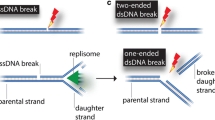Summary
Hepatitis B virus (HBV)-induced hepatocellular carcinoma (HCC) is one of the most frequently occurring cancers. Hepadnaviral DNA integrations are considered to be essential agents which can promote the process of the hepatocarcinogenesis. More and more researches were designed to find the relationship of the two. In this study, we investigated whether HBV DNA integration occurred at sites of DNA double-strand breaks (DSBs), one of the most detrimental DNA damage. An 18-bp I-SceI homing endonuclease recognition site was introduced into the DNA of HepG2 cell line by stable DNA transfection, then cells were incubated in patients’ serum with high HBV DNA copies and at the same time, DSBs were induced by transient expression of I-SceI after transfection of an I-SceI expression vector. By using nest PCR, the viral DNA was detected at the sites of the break. It appeared that integration occurred between part of HBV x gene and the I-SceI induced breaks. The results suggested that DSBs, as the DNA damages, may serve as potential targets for hepadnaviral DNA insertion and the integrants would lead to widespread host genome changes necessarily. It provided a new site to investigate the integration.
Similar content being viewed by others
References
Takahashi S, Chayama K. Integration of hepatitis B virus DNA and hepatocellular carcinoma. J Gastroenterol Hepatol, 2005,20(8):1141–1142
Kimbi GC, Kramvis A, Kew MC. Integration of hepatitis B virus DNA into chromosomal DNA during acute hepatitis B. World J Gastroenterol, 2005,11(41):6416–6421
Minami M, Daimon Y, Mori K, et al. Hepatitis B virus-related insertional mutagenesis in chronic hepatitis B patients as an early drastic genetic change leading to hepatocarcinogenesis. Oncogene, 2005,24(27):4340–4348
Peter M, Rosty C, Couturier J, et al. MYC activation associated with the integration of HPV DNA at the MYC locus in genital tumors. Oncogene, 2006,25(44): 5985–5993
Miyagawa K. Double-strand break repair and chromosomal instability. Rinsho Ketsueki, 2009,50(6):474–480
Bill CA, Summers J. Genomic DNA double-strand breaks are targets for hepadnaviral DNA integration. Proc Natl Acad Sci USA, 2004,101(30):11 135–11 140
Gozuacik D, Murakami Y, Saigo K, et al. Identification of human cancer-related genes by naturally occurring hepatitis B virus DNA tagging. Oncogene, 2001,20(43): 6233–6240
Nickoloff JA, Brenneman MA. Analysis of recombinational repair of DNA double-strand breaks in mammalian cells with I-SceI nuclease. Methods Mol Biol, 2004, 262:35–52
Paran N, Geiger B, Shaul Y, et al. HBV infection and cell culture: evidence for multivalent and cooperate attachment. EMBO J, 2001,20(16):4443–4453
Kinner A, Wu W, Staudt C, et al. γ-H2AX in recognition and signaling of DNA double-strand breaks in the context of chromatin. Nucleic Acids Res, 2008,36(17): 5678–5694
Sohn JA, Litwin S, Seeger C, et al. Mechanism for cccDNA synthesis in hepadnaviruses. PLoS One, 2009, 4(11):e8093
Mazet-Wagner AA, Baclet MC, Loustaud-Ratti V, et al. Real-time PCR quantitation of hepatitis B virus total DNA and covalently closed circular DNA in peripheral blood mononuclear cells from hepatitis B virus-infected patients. J Virol Methods, 2006,138(1–2):70–79
Takkenberg RB, Zaaijer HL, Molenkamp R, et al. Validation of a sensitive and specific real-time PCR for detection and quantitation of hepatitis B virus ovalently closed circular DNA in plasma of chronic hepatitis B patients. J Med Virol, 2009,81(6):988–995
Löbrich M, Shibata A, Beucher A, et al. γ-H2AX foci analysis for monitoring DNA double-strand break repair: strengths, limitations and optimization. Cell Cycle, 2010,9(4):662–669
Nassal M. Hepatitis B viruses: reverse transcription a different way. Virus Res, 2008,134(1–2):235–249
Alexandru Caruntu F, Molagic V. cccDNA persistence during natural evolution of chronic HBV infection. Romanian J Gastroenterol, 2005,14(4):373–377
Sakurai Y, Komatsu K, Agematsu K, et al. DNA double strand break repair enzymes function at multiple steps in retroviral infection. Retrovirology, 2009,15(6): 114–127
Feitelson MA, Lee J. Hepatitis B virus integration, fragile sites, and hepatocarcinogenesis. Cancer Lett, 2007, 252(2):157–170
Chemin I, Zoulim F. Hepatitis B virus induced hepatocellular carcinoma. Cancer Lett, 2009, 286(1):52–59
Petersen J, Dandri M, Burkle A, et al. Increase in the frequency of hepadnavirus DNA integration by oxidative DNA damage and inhibition of DNA repair. J Virol, 1997,71(7):5455–5463
Shrivastav M, De Haro LP, Nickoloff JA, et al. Regulation of DNA double-strand break repair pathway choice. Cell Res, 2008,18(1):134–147
Dandri M, Burda MR, Burkle A, et al. Increase in de novo HBV DNA integrations in response to oxidative DNA damage or inhibition of poly (ADP-ribosyl)ation. Hepa tology, 2002,35(1):217–223
Abel S, De Kock M, van Schalkwyk DJ, et al. Altered lipid profile, oxidative status and hepatitis B virus interactions in human hepatocellular carcinoma. Prostaglandins Leukot Essent Fatty Acids, 2009,81(5–6):391–399
Barash H, Gross ER, Edrei Y, et al. Accelerated carcinogenesis following liver regeneration is associated with chronic inflammation-induced double-strand DNA breaks. Proc Natl Acad Sci U S A, 2010,107(5):2207–2212
Feitelson MA, Reis HM, Tufan NL, et al. Putative roles of hepatitis B x antigen in the pathogenesis of chronic liver disease. Cancer Lett, 2009,286(1):69–79
Author information
Authors and Affiliations
Corresponding author
Additional information
This project was supported by grants from National Natural Sciences Foundation of China (No. 30872237) and the National Basic Research Program of China (No. 2007CB512900).
Rights and permissions
About this article
Cite this article
Hu, X., Lin, J., Xie, Q. et al. DNA double-strand breaks, potential targets for HBV integration. J. Huazhong Univ. Sci. Technol. [Med. Sci.] 30, 265–270 (2010). https://doi.org/10.1007/s11596-010-0341-8
Received:
Published:
Issue Date:
DOI: https://doi.org/10.1007/s11596-010-0341-8




